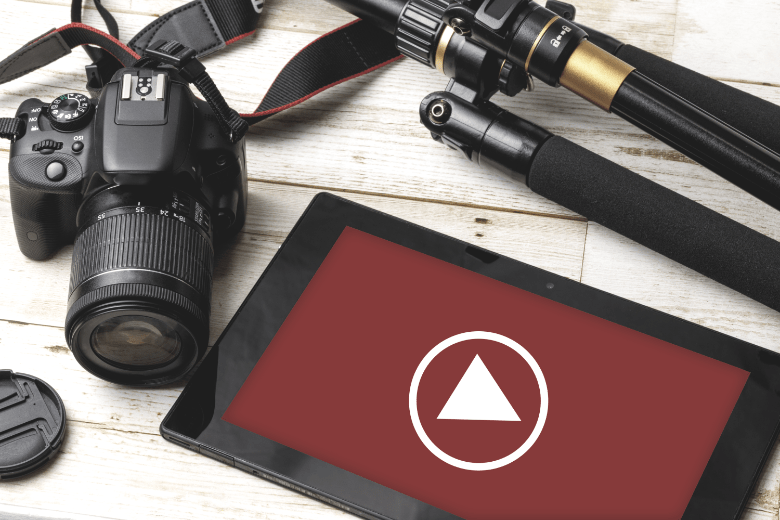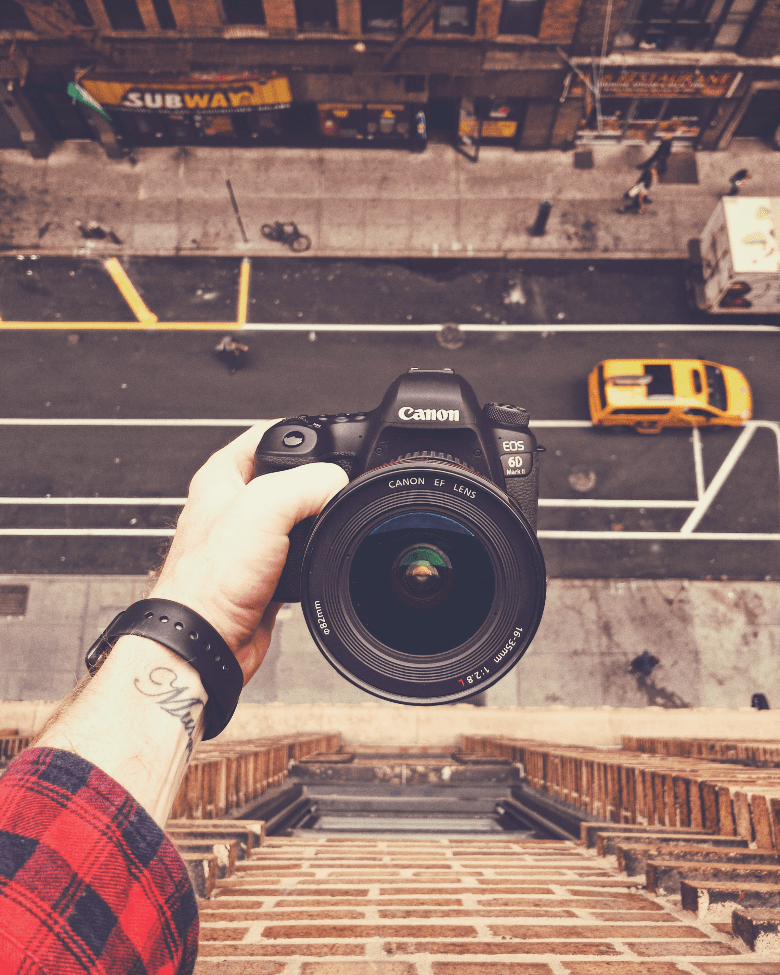When starting a vlog there are key choices you need to make from the outset. These choices will help ensure you have a plan to reach the right audience and achieve success.
As such a huge topic it’s hard to cover everything. This article focuses on basics within each part of the production process to help you think about key choices that will help define your vlog.
This article sources key vlogging beginner tips from YouTube Certified experts and the YouTube Creator Academy. This will help you learn the best practices from the outset.
The tips are YouTube focused given it’s ubiquity, range of features and search ranking system. The platform’s search engine help your videos find the widest possible audience online. So let’s dive in so you can start to share your story with the world online.
Pre-production – Before You Hit Record
Before pressing the record button you need a plan. This will not only improve your next video you’re making but increase your channel’s success as a whole. So even at this early stage it’s worth making a plan for your channel beyond the first video.
The YouTube Creators Academy recommends beginner vloggers answer these questions for their channel:
- How would you like to have an impact?
- What do you want to say?
- What knowledge can you share with others?
Your answers to the above questions will help define your channel’s niche.

CHANNEL NICHE
One of the best things about YouTube is that you can find a community no matter what you’re passionate about – whether it’s comedy, sports, fashion, gaming, food or simply everyday life.
Choose a niche you’re passionate about as it’s important to be authentic. It also helps to know the latest trends i.e. what’s popular, controversial even and searchable. These key factors will help your videos be seen more and build an audience.
Choosing a niche will also help later when it comes to optimising and promoting your videos. This will also be key if you choose to monetize your channel later. We cover this in the distribution section.
You want to balance choosing a specific niche with audience demand. Your chosen niche should have a dedicated audience. This will help your channel grow overtime.
YOUR AUDIENCE
To create a successful vlog you need to research and understand your niche’s target audience. Think about the value your videos could bring your audience. This will increase your chances of creating a successful channel long term.
Search YouTube for inspiration from other creators in your niche. See what made their recent videos successful. This will show you what kind of videos are currently popular.
YouTube Certified expert Tim Schmoyer believes successful vlogs give value to their audiences. The video should cover something they want to aspire to, become or relate.
‘You’re ultimately telling your story but you’re actually telling your viewers story through your story’ Tim Schmoyer
Knowing which types of videos are popular within your niche as well as your target audience needs. This will increase the chances they watch, subscribe and share your channel.
YOUR CHANNEL
At this early stage it’s still important to have a vision for your channel to be beyond your first few videos. This could evolve but thinking about it helps chances of success later.
Researching your niche on YouTube will show you the type of videos popular with your audience. Here are key factors to consider for both your videos and channel:
Format
Choosing a video format is not an exact science but here’s a couple of factors to consider:
- YouTube values ‘watch time’ as a key metric for ranking.
- The platform prioritises the videos watched start to finish.
- Keep this in mind when you’re deciding the length of your videos.
- The more watch time your video has, the more YouTube will promote it.
When starting out it’s a good idea to see which video format is popular in your chosen niche and follow those. This can evolve later as your channel grows.
‘You need to know the rules before you can break them’ YouTube Certified expert Tim Schmoyer explains why.
Frequency
Another factor to consider when starting out is how often do you plan to post videos.
You can upload daily, weekly, fortnightly or even monthly.
Try to stick to a fixed frequency and schedule. YouTube’s algorithm rewards consistent channels with higher ranking in search. Consistency is a key YouTube ranking factor.
CONSISTENCY
Being consistent also helps create a loyal fan base among your subscribers. It will help them know when to visit your channel next.
Here’s a couple of tips for helping consistent video uploads:
- Create an upload schedule in your calendar to help remind you.
- Plan to shoot your videos in batches of three or four videos at a time as it’s more efficient.
- Then edit and upload one each week after.
Lastly, the time you choose to post consistently becomes best time to post in the eyes of YouTube. This is rewarded in search rankings with subscribers knowing when to tune in.
Style
This is where you can differentiate yourself from other creators. Decide on your tone. Is it going to be informational, motivational, entertaining or a mix of styles.
Another way to stand out is to give your channel a hook or gimmick and something novel. This could help in deciding channel name too. Think about your favourite YouTube creators and what makes them memorable to you.
This YouTube Creators Academy video shows how YouTuber Camille Johnson came up with her channel name ‘OffbeatLook’
Start thinking about channel branding before you start vlogging. Try not to overthink it and risk analysis paralysis. It’s important to start the camera rolling and make videos.
Production – Start Recording
Having thought about your vlog’s niche, the audience and video style it’s time to start making videos.
Equipment
When beginning to vlog your equipment does not need to be expert-level or expensive. At first just ensure your videos are watchable. First think about having good audio, visual and lighting (AVL). This can be done on a minimal budget with gear you may have.
Camera
Obvious but when starting you can use the camera on your phone. Most smart phones have HD cameras, some even shooting 4K. This more than you need to make great online videos.
Webcams are another good beginner option on a budget. Most laptops have them or spending $50 or more will get you one good enough to start.
Depending on your niche using screen capture software can be a decent choice. Especially if you’re not wanting or needing to be on camera. There are some great free options for this.

Tripod
Using any type of hand held camera, including your smartphone, it will be worth investing in a tripod. Create a makeshift one if on a budget using books stacked on desk or flat surface to get the right height. More on this in the Shooting Tips section below.
Lighting
Lighting basics 101 for beginners is to make sure to have your main light source behind the camera.This applies where indoors or out in the open. With the light or sun behind you instead will make you a silhouette on the camera. An amateur mistake.
Keep an eye on light levels when outdoors. Be aware of how natural light can impact on your picture quality. Adjust camera angle or your filming style if necessary.
Sound
The amount you need to invest on a mic will depend on what kind of videos you’re planning to make. A $30 mic can be as effective for most vlogging videos than $300 mics.
Location is also a big factor to consider sound-wise.
Location
To help your first videos and avoid AVL mistakes pick locations with:
- Decent natural light or with main light source out of shot.
- A quieter place that has a consistent levels of low noise.
- Background which is not over distracting.
- Keep in mind your background will become a character in your videos.
- Especially when used in several most videos becoming part of your brand.
When starting out an indoor location is often a safer choice as the above factors are easier to control.
Shooting Tips
Here’s key shooting tips on planning, being on camera and signing off before you hit record:
Plan
Before recording think about why are the audience wanting to watch?
- for entertainment – tease the story you’re about to tell
- for information/educational – introduce the topic at hand
- what’s the reward the viewer will get from watching the video
Having a scripted outline for your video is a good way to overcome nerves. Weaving in a little humour where appropriate can help too and try to make every second count.
Hook your audience in the beginning 10 seconds by making your video opening relevant. Do this by having the intro show that your video is about to deliver on the thumbnail your audience clicked.

On Camera
First up, be sure to look into the camera lens and NOT the viewfinder. This is a common beginner mistake which many make. Also, avoid having your head in centre of frame and instead lower camera so head at top and body in shot. This makes for better composition.
Being yourself is the quickest way to feel natural in front of the camera. Imagining you’re excited to be talking to a close friend helps increase your energy on camera. Cameras have a trick of somehow reducing energy levels on screen so keep this in mind. Low energy kills attention.
The more you do it, the more confidence you’ll build so practice with several takes. Then re-watch it to see how you can improve.
Sign-off
Adding a call to action at the end of videos is a great opportunity to further engage with your audience:
- This can be by asking a question for the audience to reply to in the comments
- Telling them about another related video or relevant playlist.
- Most importantly asking them to subscribe to your channel.
Remember that if you find yourself making a mistake or running out of steam you can fix in edit by adding a jump cut in post production. Keeping your AVL in mind too and how to improve it will make post-production easier.
Post- Production
Editing
There’s a whole host of editing software, free to advanced premium software, to choose from. At this stage either Apple iMovie or Windows Movie Maker are both fine.
An alternative editor software is the free version of DaVinci. This has more features and can be upgraded to premium software. The premium upgrade is less expensive than both Final CutPro and Adobe Premiere. It’s well rated among professional editors.
In this YouTube Creator Academy video, YouTube creator Kia (from the channel TheNotoriousKIA) gives a total beginner’s guide to video editing.
As mentioned above, use jump-cuts create energy allowing you to truncate time and jump forward efficiently.
Music
Using royalty free music is highly recommended especially when on a budget. YouTube will prevent monetizing your videos by muting them so they can’t be watched. YouTube will delete your channel if you break the ‘three strike rule’ on using copyrighted music.
Channel Branding in Post
Channel branding should be thought about in pre-production at the idea stage. However, it’s in post-production where you will create most of your channel branding assets. You’ll need these to promote both your videos and channel as a whole.
Thumbnails
These are key for promotion. See them as mini-posters advertising your videos. You set the audience expectation for your video with both the thumbnail and the title. It’s useful to have these in mind before you start filming.
Channel Banner
This goes across the top of your YouTube channel homepage. Be aware it can resize and look different depending on what device your video is being watched from. This branding asset can share your upload schedule and updates for your viewers too.
Channel Icon
Many creators use either a logo they’ve created or a face shot of themselves. Aim to make it something visual that can have instant brand recognition.
Channel Trailer
Once you’ve uploaded five videos or more use the best clips to produce an engaging trailer. It should best reflect your channel’s theme and message.
Try to show your channel branding on screen during your video while pitching what you do in your videos in a brief five second pitch as you welcome viewers.
Call to Action
As mentioned earlier in the production section. Whilst filming you give a ‘call to action’. Now in post-production you insert your end screen cards to support your chosen ‘call to action’.
Distribution
Now you’ve produced your videos it’s time to reach out and find their audience. YouTube can help get your videos seen in many ways.

Optimization
To help get your videos seen you want to ensure they have the best chance of being found in search results. The following tips will help your videos rank higher in YouTube search results:
Video Description and Title
- Use searchable keywords to describe your video in a natural clear way.
- For the title try to use something current, a trend within your chosen niche.
- BUT avoid using abbreviations or insider language which needs explaining.
- Always craft titles for people first, not for search engines.
Channel Description
- Similar advice to the video description above.
- Add links to social media accounts and website if you have one.
- You can also list your upload schedule here and vision for the channel.
Monetization
As a beginner it’s recommended to optimize your videos before trying to monetize your channel too early. Monetizing may distract viewers who want to value and trust your content first.
Building an audience on trust will help in the long run as creating a successful channel is a marathon not a sprint.
Promotion
Your own social network contacts are a good starting point for building views. You’ll likely need to reach beyond them to promote your channel further too.
You can do this on YouTube by commenting on others creators in your niche. Especially where it’s relevant and adds value. Remember not to spam but try to add value with your comments.
A top tip is to focus on taking the time to invest in building relationships with other creators. From this you can cross promote each other’s videos and reach new relevant audiences.
Posting on social media platforms where relevant using hashtags can help drive views. Other online forums such as reddit related to your niche are also a potential traffic source.
Expect feedback both positive and negative from your audience. It’s the internet after all… but stay focused on the positive. Ignore the naysayers and focus on the motivators.
Summary
This overview should give you enough know-how to start your channel. Check the links within the article for more tips from YouTube certified experts and the YouTube Creators Academy.
The most important thing is to make a start. Every creator, no matter how big, had to overcome growing pains when starting out. Try to avoid analysis paralysis by over thinking to seek perfection – done is sometimes better than perfect.

